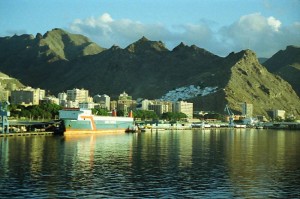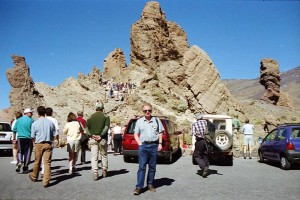




AI-99 USA (New York), Gibraltar (UK), Madeira (PORTUGAL), Canary Islands (SPAIN), CAPE VERDE ISLANDS, Ascension Island (UK), St. Helena (UK), Tristan da Cunha Islands (UK), South Georgia Island (UK), Falkland Islands (UK), ARGENTINA
Date of travel: Oct 11 – Nov 29, 1999 (the whole trip 50 days, sailing 45 days)
ITINERARY:
On Oct 11 late in the afternoon I drive in Budget rented car from Vista to Los Angeles airport. There I board a TWA plane to New York where next day early in the morning. I have 12 hours between planes. By bus andsubway,I get to 34thSt. I visit the “Empire State Building” and take pictures from its 86thfloor. I continue 5th Avenue and 42nd St. to “Grand Central Station,” then to“UN Building,” on 47th St. to “Rockefeller Center” and “Time Square” between 42nd and 47th St. Then back to JFK airport. In the evening I take a British Airways (BA) plane to London-Gatwick.
On Oct 13 early in the morning after 7-hr flight I land in London-Gatwick in UK. Soon I am on another BA plane flying 2.5-hr to Gibraltar, UK. We are taken to our hotel. I share room with 76-year old Filipino-American who has traveled extensively. I do sightseeing in the afternoon. The British Colony is aplace to visit. 6 km in length, 1 km in width most of it is filled with limestone mountain. Next day there is a bus tour of the “Rock.” Due to limestone Gibraltar is full of caves. Some have stalactites and stalagmites, others are used for defense. We visit some of them. A cable car takes us to top. There are “Barbary Macaque” (monkeys) all over. From a lighthousewe see mountains in 16 km distant Morocco. Late in the afternoon we board our Russian ship “Lyubov Orlova.” The ship starts its journey through Atlantic Ocean.
Next two days are on the ocean. “Lyubov Orlova” used to be a cargo ship. While sailing it is being equipped with cabins. Not all passengers have cabins they paid for from the first day. I share cabin with the Filipino.Russian owner is on board. The crew and hotel personal are all Russians. There are 3 Canadians from Marine Expedition who run the expedition and 3 lecturers. The lectures start immediately.
Read more
AF-10 West Coast of Africa – MOROCCO (Lanzarote, Canary Islands, Spain), Western Sahara (Morocco), SENEGAL, GAMBIA, SIERRA LEONE, GHANA, TOGO, BENIN, CAMEROON, GABON, SAN TOME & PRINCIPE, REPUBLIC CONGO, NAMIBIA, SOUTH AFRICA, NETHERLANDS
Date of travel: Nov 30, 2010 – Jan 10, 2011
ITINERARY:
An hour after midnight on Nov 30, 2010 I leave Vista and in a rented car drive to Los Angeles airport. Here I board a plane for New York, where I change to Royal Air Maroc flight to Casablanca, MOROCCO, landing there in the morning on Dec 1. After several hours in a hotel we board our ship “Corinthian II.” Next morning a bus tour of Casablanca with sightseeing of “The Hassan II. Mosque” and of the country capital, Rabat. Overnight our ship sailed to Safi, from where we drive to see mysterious Marrakesh with its Koutouba Minaret and Djemaa El Fna Square. On Dec 4, our ship is moored in Agadir and we make a bus trip to walled town Taroudanut.
At noon on Dec 5 Corinthian II. makes its port in Arrecife on the island of Lanzarote on CANARY ISLANDS, part of Spain. In the afternoon, I take a trip through this volcanic island with its whitewashed houses and collection of art by local artist Cesar Manrique.
On Dec 6 we were to visit Laayoune, a capital of WESTERN SAHARA which was annexed by Morocco in 1975, but for high waves and possible terrorist danger we will visit Dakhla in southern part of this territory tomorrow. So the next day there is a bus tour of Dakhla and its vicinity. At a beach there are sand dunes and in them a large camp with Europeans and their RV’s. They stay here part of the winter. We have opportunity to walk the streets of Dakhla in the afternoon.
After a day on the Atlantic Ocean our ship takes mooring in harbor of Dakar, SENEGAL on Dec 9. In the afternoon by ferry to Goree Island. From there the slaves were shipped to both Americas and Caribbean (my second visit to this island). Next day there is a sightseeing tour of 4 mil. city Dakar, a capital of Senegal, and afternoon we drive 42 km out of the city to “Pink Lake.” Local people dig salt from its bottom. There is also a visit to a Fulany village.
Read more
